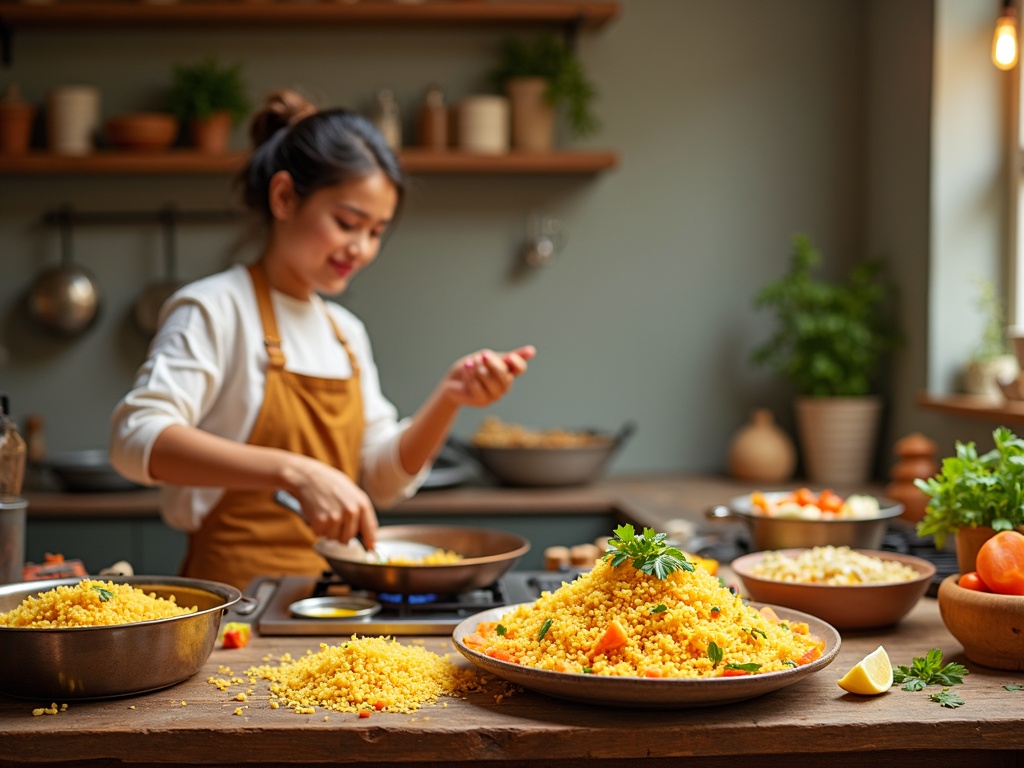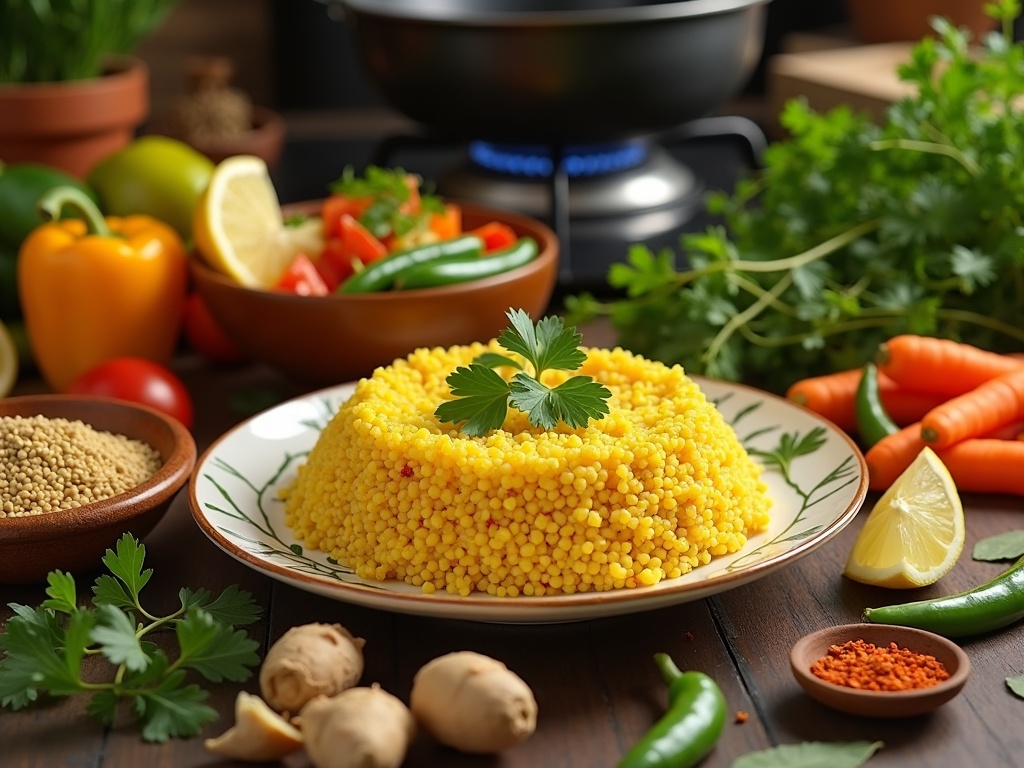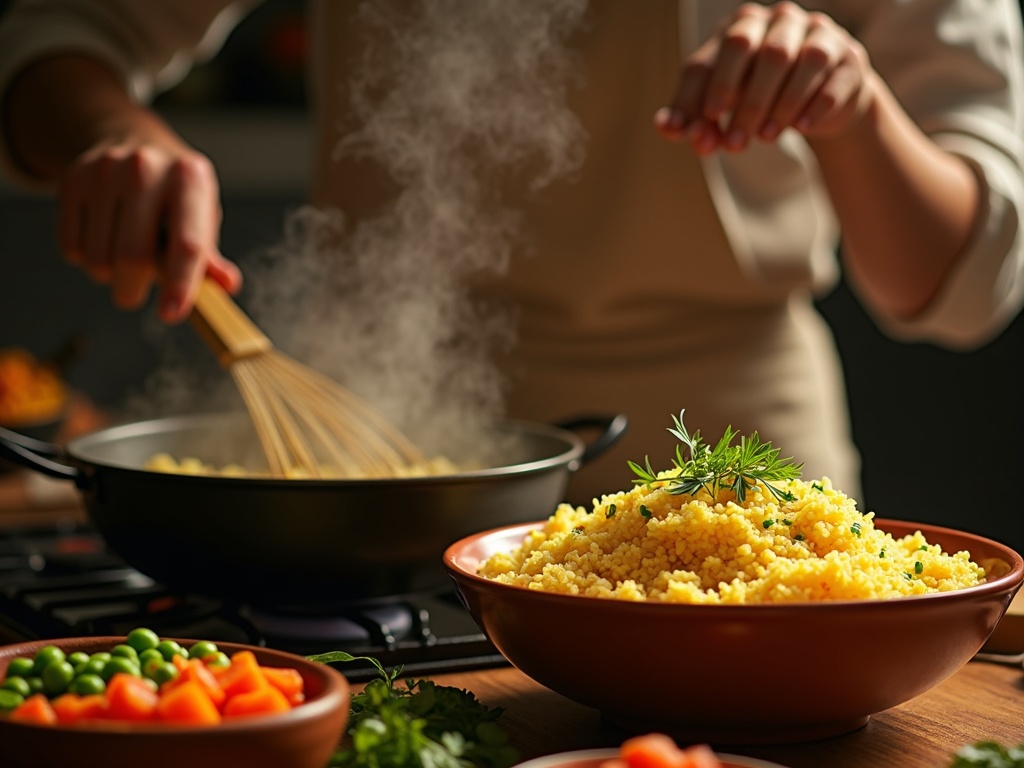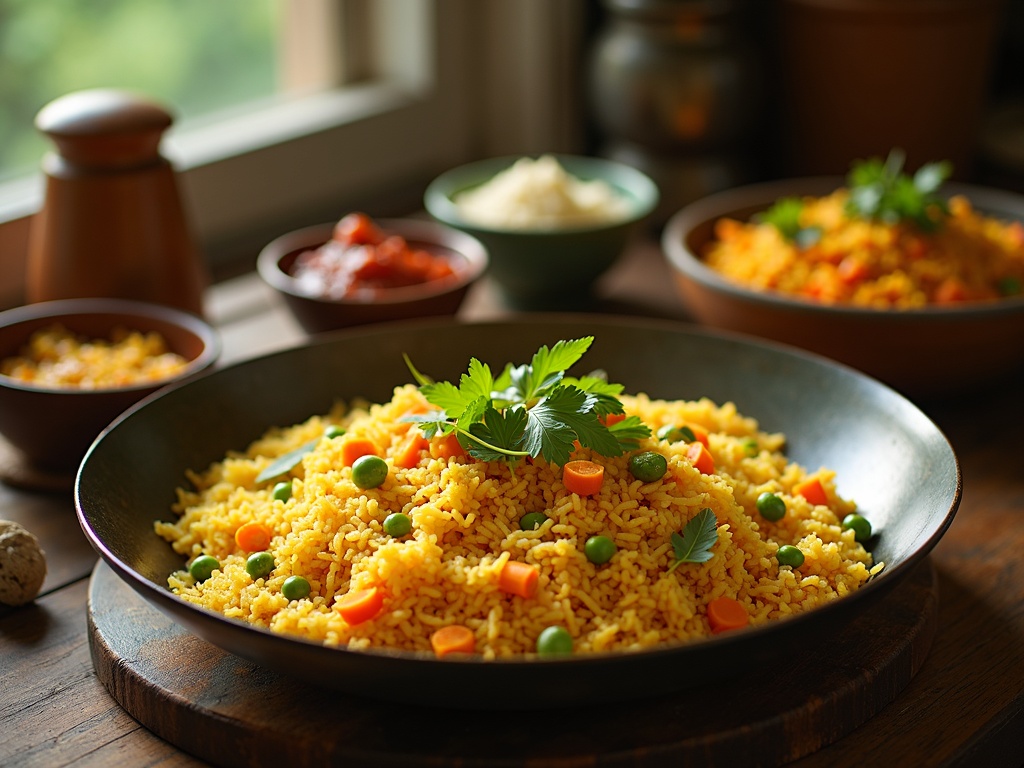Upma recipe, a versatile Indian breakfast dish made with semolina, offers the perfect blend of flavor, nutrition, and customization possibilities. The key to perfect upma lies in properly roasting the semolina before cooking and maintaining a precise water-to-grain ratio of 2:1, creating that signature fluffy texture that makes this dish so beloved.
Find In This Article
Key Takeaways
- Dry roasting the semolina until light golden is crucial for preventing lumps and enhancing the nutty flavor profile.
- The tempering process with mustard seeds, curry leaves, and vegetables creates the aromatic base that defines authentic upma.
- The dish can be customized with various vegetables, proteins like moong dal, and nuts for added nutrition and texture.
- Constant stirring while adding hot water prevents lumps and ensures the perfect grainy consistency.
- Upma pairs wonderfully with accompaniments like coconut chutney, tomato chutney, or a squeeze of lemon for a complete meal.
The Perfect Way to Make Traditional Upma
Traditional upma is a savory Indian breakfast dish that’s quick to prepare and deeply satisfying. I’ve perfected this recipe over time, and with these step-by-step instructions, you’ll be able to create restaurant-quality upma at home in just 15-20 minutes.
Mastering the Base Ingredients
The key to perfect upma lies in the ratio of ingredients. I use a 1:2 ratio of semolina (rava) to water for the ideal consistency—neither too dry nor too soggy. This proportion creates that fluffy texture that makes upma so comforting.
Before adding any water, I always dry roast the semolina in a pan for 5-7 minutes until it turns a light golden color and releases a nutty aroma. This crucial step prevents the upma from becoming lumpy and enhances its flavor profile significantly.
The Tempering Process
The tempering (or tadka) is what gives upma its characteristic flavor:
- Heat 2 tablespoons of oil in a deep pan.
- Add 1 teaspoon of mustard seeds and wait until they splutter.
- Toss in a handful of curry leaves, 1 chopped green chili, and a pinch of asafoetida for aroma.
- Add finely chopped onions, grated carrots, green peas, and any other vegetables you prefer.
- Sauté the mixture until the onions become translucent—about 3-4 minutes.
This aromatic base is what differentiates ordinary upma from truly excellent upma. I find that adding a bit of ginger at this stage adds a subtle warmth to the dish.
After the tempering is ready, I add the roasted semolina and stir it briefly to combine with the spices. Then comes the crucial moment—adding 2 cups of boiling water while stirring continuously to prevent any lumps from forming. The hot water helps the semolina cook evenly and absorb all the flavors from the spices and vegetables.
I keep stirring for about 2-3 minutes until the mixture thickens and the water is fully absorbed. A final garnish of fresh coriander leaves, a squeeze of lemon juice, and a spoonful of ghee takes this humble dish to new heights.
Try this upma recipe for breakfast or a light evening meal—it’s filling, nutritious, and can be customized with your favorite vegetables and spices.

Essential Ingredients and Their Benefits
The foundation of a delicious upma starts with selecting the right ingredients. Each component not only contributes to the dish’s distinctive flavor but also offers nutritional benefits.
Core Components and Their Nutritional Value
Coarse semolina (rava) forms the base of traditional upma. This ingredient packs quite a nutritional punch with approximately 600 calories, 18g of protein, 126g of carbohydrates, and 2g of fiber per cup. I always recommend using high-quality coarse semolina rather than fine varieties, as it creates a more satisfying texture in the final dish.
Fresh vegetables add both color and nutrition to upma. Carrots, with their vibrant orange hue, contain around 41 calories per 100g, while green peas offer approximately 81 calories per 100g. I like to add these vegetables not just for their visual appeal but also for their fiber content and micronutrients.
The aromatic spices are what transform basic ingredients into a flavorful meal. Key spices include:
- Mustard seeds: These tiny seeds release a nutty flavor when popped in hot oil
- Curry leaves: A staple in South Indian cooking that adds a unique aroma
- Green chilies: Provide heat that can be adjusted to taste
- Ginger: Adds a warming, spicy note plus digestive benefits
The nutritional content of your upma can vary significantly based on which vegetables you choose to include. I often customize my recipe based on seasonal availability, sometimes adding bell peppers for vitamin C or spinach for iron.
When preparing upma at home, the quality of semolina makes a noticeable difference in the final texture. The coarser variety absorbs moisture more evenly, resulting in upma that’s fluffy rather than gummy. This texture difference transforms the eating experience, making each spoonful more enjoyable.
For best results, I toast the semolina lightly before adding liquids. This extra step enhances its nutty flavor and prevents clumping during cooking.

Health and Nutrition Facts
Traditional upma offers a balanced nutritional profile that makes it an excellent choice for a wholesome meal or snack. A typical serving contains between 180-250 calories, depending on the ingredients and cooking method used. I’ve found this makes it perfect for those monitoring their calorie intake while still wanting a satisfying dish.
Macronutrient Breakdown
Upma is primarily rich in complex carbohydrates from the semolina base, providing sustained energy throughout the day. Unlike many processed breakfast options, its low fat content makes it a heart-healthy choice when prepared with minimal oil. The semolina base offers a good amount of energy without weighing you down.
For those looking to increase their protein intake, adding moong dal can significantly enhance the nutritional value. A cup of cooked moong dal provides approximately 14g of protein, transforming upma from a carb-focused dish to a more balanced meal. This simple addition is particularly valuable for:
- Athletes and active individuals needing muscle recovery support
- Vegetarians and vegans seeking complete plant-based protein sources
- Growing children who need adequate protein for development
- Elderly individuals requiring sufficient protein intake
Micronutrient Content
The vegetables incorporated into upma contribute essential micronutrients that enhance its health profile. Carrots, peas, onions, and other vegetables add significant amounts of iron and phosphorus to the dish. Iron supports healthy blood formation and oxygen transport, while phosphorus plays a crucial role in bone health and energy metabolism.
I’ve noticed many home cooks don’t realize upma can be customized to address specific nutritional needs. By incorporating calcium-rich ingredients like sesame seeds or iron-rich vegetables like spinach, you can tailor the recipe to target particular health concerns.
The spices used in upma also offer health benefits beyond flavor. Mustard seeds contain antioxidants, while curry leaves have anti-inflammatory properties. Ginger aids digestion, making upma not just nutritious but also gut-friendly.
This versatile dish fits easily into various dietary patterns, including vegetarian and vegan lifestyles. Its balanced nutrient profile provides steady energy release rather than the spikes and crashes associated with sugary breakfast options. This makes it particularly suitable for:
- Busy professionals needing sustained mental focus
- Students preparing for exams or long study sessions
- Anyone managing blood sugar levels or insulin sensitivity
- Those looking for satiating meals that prevent midday hunger
The whole grain nature of semolina (when using unrefined varieties) adds fiber to the dish, supporting digestive health and promoting a feeling of fullness. This fiber content, combined with the complex carbohydrates, helps regulate blood sugar and provides lasting energy throughout the morning.
When prepared with minimal oil and plenty of vegetables, upma represents a nutrient-dense meal option that delivers multiple health benefits in a single, delicious dish. Its adaptability allows for nutritional customization while maintaining its characteristic comfort-food appeal.

Serving Ideas and Accompaniments
I serve upma warm as a satisfying breakfast or an energizing afternoon snack. This versatile dish shines brightest when it’s freshly made and steaming hot. A final garnish of chopped fresh coriander leaves and a squeeze of tangy lemon juice brightens the flavors and adds a pop of color.
Perfect Pairings for Your Upma
Coconut chutney makes an excellent companion to upma’s savory profile. At approximately 70 calories per tablespoon, this cool, creamy condiment provides a delightful contrast to the warm, spiced grain dish. I make mine with freshly grated coconut, green chilies, and a hint of ginger for an authentic flavor.
For those who prefer something with more heat, spicy tomato chutney offers a zesty alternative. The tangy tomato base with red chilies creates a flavor explosion that complements the subtle spicing in the upma recipe perfectly.
The beauty of serving upma lies in customization. I often set out multiple chutney options when hosting breakfast or brunch:
- Mint-coriander chutney for herbaceous freshness
- Peanut chutney for nutty richness
- Ginger chutney for a spicy kick
- Lemon pickle for those who enjoy tanginess
These accompaniments allow everyone to adjust the flavor profile to their preference. Some guests enjoy mixing a bit of yogurt into their upma for a creamier texture and cooling effect.
Traditional South Indian households often serve upma with filter coffee, creating a breakfast experience that’s both filling and energizing. For a complete meal, I sometimes pair it with fresh seasonal fruit on the side.
Expert Tips for Perfect Texture
I’ve learned through years of cooking that mastering upma’s texture transforms it from an ordinary breakfast to an extraordinary one. The key lies in a few simple yet crucial techniques that elevate this humble dish.
Preparation Techniques
Roasting the semolina before cooking is non-negotiable for achieving that distinctive nutty flavor. I heat a heavy-bottomed pan over medium flame, add the semolina, and toast it until it turns light golden and releases a wonderful aroma. This pre-roasting not only enhances flavor but also helps prevent lumps later in the cooking process.
Constant stirring is another vital technique I never skip. Once I add liquid to the semolina, I keep my spoon moving continuously. This prevents those frustrating lumps that can ruin the dish’s texture. For particularly smooth results, I use a whisk during the initial liquid addition, then switch to a wooden spoon as the mixture thickens.
The temperature of water matters significantly. I always ensure my water is boiling hot when adding it to the roasted semolina. This immediate heat reaction helps create that perfect grainy texture that defines good upma. Cold or lukewarm water leads to a gummy consistency that’s difficult to salvage.
Enhancing Elements
Adding fresh vegetables elevates upma both nutritionally and texturally. I incorporate:
- Finely diced carrots for sweetness and bright color
- Green peas for pops of texture
- Diced bell peppers for crunch
- Chopped French beans for substance
- Minced green chilies for heat
These vegetables should be sautéed until just tender before adding the semolina—overcooking them results in a mushy final dish.
Monitoring consistency while cooking makes all the difference. I start with a water-to-semolina ratio of 2:1, but adjust based on how the mixture develops. If it seems too dry, I add hot water a tablespoon at a time. The perfect upma should be fluffy and each grain should be separate, not clumped together.
For restaurant-quality results, I cover the upma and let it rest for 5 minutes after cooking. This final steaming helps moisture distribute evenly, resulting in that coveted light, fluffy texture that makes upma so satisfying. With these techniques, even beginners can create upma with perfect texture every time.

Customization Options
Upma is such a versatile dish that I often modify based on what’s available in my kitchen or my mood that day. The basic recipe serves as an excellent foundation, but adding your personal touch can transform this humble breakfast into something extraordinary.
Protein and Texture Enhancements
I love adding a quarter cup of moong dal (yellow split lentils) to my upma for a protein boost. Simply roast the moong dal along with the semolina until it turns slightly golden – this adds a nutty flavor and makes the dish more filling. For a delightful crunch, I toss in a handful of cashews, peanuts, or almonds. These nuts not only provide textural contrast but also contribute healthy fats and additional protein. Sometimes I even add some toasted sesame seeds on top just before serving for an extra dimension of flavor.
Vegetables make upma more nutritious and colorful. I recommend experimenting with seasonal produce to keep things interesting:
- Spring: Green peas, bell peppers, and spring onions
- Summer: Grated carrots, zucchini, and tomatoes
- Fall: Sweet potatoes, spinach, and cauliflower florets
- Winter: Cabbage, green beans, and beetroot
The key is to dice vegetables into similar-sized small pieces for even cooking. Harder vegetables should be added earlier in the cooking process, while softer ones can go in toward the end.
Flavor and Consistency Adjustments
Spice levels can easily be customized to suit your preference. I find that adjusting the amount of green chilies and black pepper makes the biggest difference. For a milder version, remove the seeds from the chilies before chopping. If you enjoy heat, add a pinch of red chili powder or a dash of hot sauce. A squeeze of lemon juice just before serving brightens the flavors considerably.
The water-to-semolina ratio determines the final consistency of your upma. The standard 2:1 water-to-semolina ratio produces a fluffy texture, but I sometimes prefer a slightly softer consistency by increasing the water to 2.5:1. For a drier, more separated grain texture, reduce the water slightly to about 1.75:1. Remember that vegetables release moisture during cooking, so adjust accordingly when adding a lot of vegetables.
Each variation creates a different upma experience, allowing you to enjoy this versatile dish in countless ways. Try upma variations for breakfast, lunch, or even a light dinner option.
Sources:
The Health Benefits of Semolina – The Journal of Nutritional Health
Nutrition Composition of Popular Indian Breakfast Foods – Indian Nutrition Journal
Exploring the Versatility of Upma – Indian Cuisine Digest

